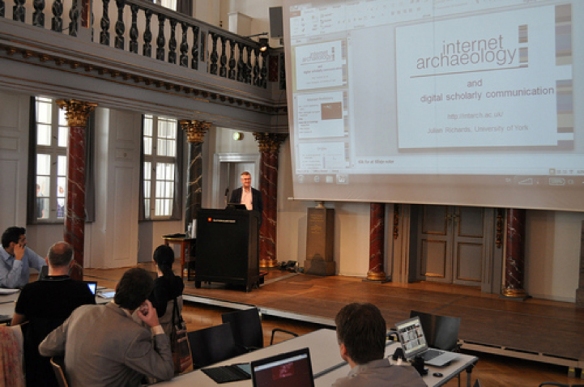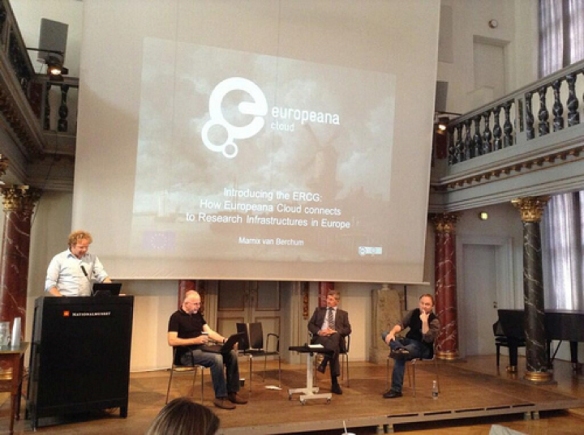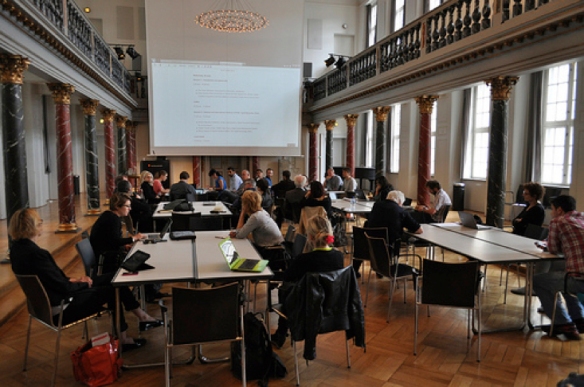Digital Humanities And The Tyranny of Distance for http://dha2014.org/ Wednesday 19 March, 2014, Hosted at University of Western Australia, Perth Australia
Slides
- Matt_Munson-DHa2014, with transitions
- Christof_Schoech_DHa2014_Collaborative-Academic-Writing
- Erik_Champion-DHa2014-BirdsOfAFeather
- (Toma Tasovac spoke from the heart, no slides).
Talk 1 (virtual): No Panacea: How Can Virtual Research Environments Enhance Distance Research-Matt
After a recent report on virtual research environments (VREs) from the Joint Information Systems Council in the UK (JISC) found that, even after 6 years of funding and study by JISC, “the ‘emergent community of practice’ has failed to grow significantly beyond the pool of practitioners in direct receipt of JISC project funds,”[1] perhaps it is time to step back and consider whether VREs truly can be a useful addition to humanities research and, if so, under what circumstances. This paper will discuss the areas in which scholars should expect VREs to assist them in distance research (access to the same tools, data, and workflows in a single environment) and the price they will need to pay for these advantages (either significant time and energy to develop their own environment or being satisfied with a pre-existing solution). This paper will conclude that VREs can be an excellent tool for distance research, but one for which a significant price must be paid given the current state of existing VRE platforms.
Talk 2 (virtual): Collaborative writing in a distributed research consortium: requirements and possible solutions-Christof
This contribution reports on experiences made with collaborative writing in the DARIAH consortium (Digital Research Infrastructure for the Arts and Humanities, www.dariah.eu). DARIAH is a distributed research project involving numerous partners from 12 different European countries and in which tools supporting various collaborative writing and project coordination tasks have been used over a considerable period of time. Despite the fact that collaboration across geographical distance is essential for this and many other projects, the existence of conflicting requirements of scholarly collaborative writing processes make a generic solution very hard to come by. Among these requirements are real-time collaborative writing, flexible word-level commenting, footnote support, version control, access rights management, publishing options and open-source availability of the tool itself. Currently available technical solutions do not meet all of these requirements. Tools discussed in this contribution include Etherpad, Mediawiki/Confluence, GoogleDrive, Dropbox and WordPress. Finally, one promising solution will be discussed which is still in early stages of development, namely Penflip (www.penflip.com), a GitHub front-end for text composition.
Talk 3 (virtual): Recognizing Distance: On Multilingualism in Digital Infrastructures-Toma
Infrastructures are installations and services that function as “mediating interfaces” or “structures ‘in between’ that allow things, people and signs to travel across space by means of more or less standardized paths and protocols for conversion or translation.” [2] By definition, infrastructures are in the business of overcoming distance: they have always been seen as motors of change propelling society into a better and brighter future. Which is why it would be all too tempting — and all too easy — to approach the question of digital research infrastructures uncritically by embracing the master narratives of efficiency and progress without discussing the larger and more complex implications of institutionalizing networked research. A digital infrastructure is not only a tool that needs to be built: it is also a tool that needs to be understood. In this talk, I will address the challenge of multilingualism in research infrastructures evolving against the backdrop of global capitalism in its electronic mode, the so-called “eEmpire” [3] How can we make sure that digital infrastructures — not only the ones we are trying to build now, for ours are baby steps, but the future ones, the ones we hope to see built one day — do not turn from being power grids into grids of (hegemonic, monolingual, monocultural) power?
Talk 4 (in person): The 3D world is your stage-Erik
How can scholars collaborate in virtual environments in a manner similar to video-conferencing? Which conferencing and distributed modeling tools are particularly appropriate to research and collaboration in the spatial and artefactual humanities? This talk will briefly outline needs, issues and promising services and working prototypes.
Authors
Matthew Munson <mmunson@gcdh.de>
Matthew Munson is a researcher at the Göttingen Centre for Digital Humanities (GCDH) in Göttingen, Germany. He holds a bachelor’s degree in Education from the University of Kansas and in Theology from Loyola College (now Loyola University) in Baltimore, Maryland, and a master’s degree in Religious Studies from the University of Virginia. While a student at the University of Virginia, Matthew began working in the digital humanities center there, the Scholars’ Lab, and immediately became interested in the fascinating insights digital methods could give into ancient religious texts. He received a Scholars’ Lab Digital Humanities Fellowship in 2009-2010 to explore the use of text-mining strategies to identify relationships between the Greek texts of St. Paul in the New Testament and the Hebrew texts of the Old Testament. At the GCDH, Matthew works in the European project DARIAH (Digital Research Infrastructure for the Arts and Humanities) and coordinates the DARIAH work package concerning VREs on the German and European level and is also coordinating the development of the DARIAH international digital humanities summer school, planned for August 2014 in Göttingen. His current research interests lie in the area of semantic drift and methods of calculating the change in the meanings of words from the Old Testament to the New Testament.
Christof Schöch <christof.schoech@uni-wuerzburg.de>
Christof Schöch is a researcher at the Chair for Digital Philology, University of Würzburg, Germany, working in the DARIAH-DE (Digital Research Infrastructure for the Arts and Humanities) project. He obtained his PhD from Kassel University & Paris-Sorbonne in 2008 with a study published as La Description double dans le roman des Lumières 1760-1800. His interests in research and teaching are French Literature (Enlightenment, contemporary novel, classical drama) as well as digital humanities (scholarly digital editions, quantitative text analysis, digital infrastructure).
Toma Tasovac <ttasovac@humanistika.org>
Toma Tasovac is the director of the Belgrade Centre for Digital Humanities. He has degrees in Slavic Language and Literatures from Harvard and Comparative Literature from Princeton. He works on complex architectures in electronic lexicography, digital editions, and integration of digital libraries and language resources. He is equally active in the field of new media education, regularly teaching seminars and workshops in Germany, Eastern Europe, the Caucasus and Central Asia.
Erik Champion <nzerik@gmail.com>
A Professor of Cultural Visualisation at Curtin University, Erik was previously Project Leader of DIGHUMLAB Denmark, and co-Leader of the Research and Public Engagement part of DARIAH. His research is primarily in virtual heritage, serious games, and 3D applications in the Digital Humanities. He has postgraduate degrees in Architecture, Philosophy, and Engineering (Geomatics). He has written Playing With the Past, edited Game Mods: Design Theory and Criticism (a free download at ETC Press), and is writing Critical Gaming in the Digital Humanities.
[1] Miller, Paul, “JISC VRE Programme: Impact Study,” March 2010:http://www.immagic.com/eLibrary/ARCHIVES/GENERAL/JISC_UK/J100315M.pdf, p. 21.
[2] Badenoch, Alexander and Andreas Fickers (2010), ‘Europe Materializing? Toward a Transnational History of European Infrastructures’, in Badenoch, Alexander and Andreas Fickers (eds.), Materializing Europe: Transnational Infrastructures and the Project of Europe (Basingstoke, Hampshire; New York: Palgrave Macmillan), 11.
[3] Raley, R. (2004). eEmpires. Cultural Critique 57, 132.



